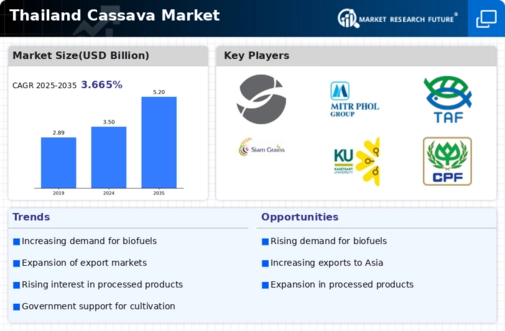Rising Health Consciousness
There is a growing trend of health consciousness among consumers in Thailand, which is positively impacting the cassava market. As more individuals seek healthier dietary options, cassava is gaining recognition for its nutritional benefits, including being rich in carbohydrates and low in fat. In 2025, it is estimated that the demand for cassava-based health products will increase by 20%, reflecting a shift towards natural and wholesome ingredients. This trend is encouraging food manufacturers to innovate and develop new cassava-based products, such as snacks and flour alternatives. Consequently, the cassava market is likely to see a diversification of its product offerings, catering to the evolving preferences of health-conscious consumers.
Increasing Export Opportunities
The cassava market in Thailand is experiencing a notable increase in export opportunities, driven by the growing global demand for cassava-based products. In 2025, Thailand is projected to export approximately 1.5 million tons of cassava, primarily to markets in Asia and Europe. This surge in exports is attributed to the rising popularity of cassava as a gluten-free alternative in food products and its use in biofuel production. The Thai government is actively supporting this trend by implementing policies that enhance the competitiveness of cassava farmers and processors. As a result, the cassava market is likely to benefit from improved trade relations and increased foreign investment, which could further stimulate growth in the sector.
Technological Innovations in Processing
Technological innovations in processing are significantly influencing the cassava market in Thailand. Advances in processing techniques, such as improved drying and milling technologies, are enhancing the quality and shelf-life of cassava products. In 2025, it is anticipated that the adoption of these technologies could increase the efficiency of cassava processing by 25%, thereby reducing production costs. This efficiency gain is likely to attract more investments in the cassava market, as manufacturers seek to capitalize on the growing demand for processed cassava products. Furthermore, these innovations may lead to the development of new applications for cassava, expanding its market reach and creating additional revenue streams for producers.
Government Support and Policy Initiatives
The Thai government plays a crucial role in shaping the cassava market through various support and policy initiatives. In recent years, the government has introduced programs aimed at enhancing the productivity and sustainability of cassava farming. For instance, subsidies for fertilizers and improved seed varieties are being provided to farmers, which could potentially increase yields by up to 30%. Additionally, the government is promoting research and development in cassava processing technologies, which may lead to higher value-added products. These initiatives are expected to strengthen the cassava market by ensuring a stable supply chain and improving the overall competitiveness of Thai cassava in both domestic and international markets.
Climate Resilience and Adaptation Strategies
Climate resilience and adaptation strategies are becoming increasingly vital for the cassava market in Thailand. As climate change poses challenges to agricultural productivity, the cassava industry is focusing on developing resilient varieties that can withstand adverse weather conditions. Research indicates that certain cassava varieties can yield up to 40% more under drought conditions compared to traditional ones. The implementation of sustainable farming practices, such as intercropping and soil conservation techniques, is also gaining traction among farmers. These strategies are expected to enhance the resilience of the cassava market, ensuring consistent supply and quality of cassava products in the face of climate variability.

















Leave a Comment